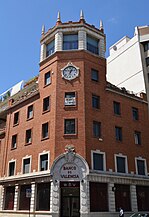This article needs additional citations for verification. (September 2010) |
Gandia
| |
|---|---|
| Motto: Sic luceant opera tua | |
 Location of Gandia | |
| Coordinates: 38°58′N 0°11′W / 38.967°N 0.183°W | |
| Country | |
| Autonomous community | |
| Province | |
| Comarca | Safor |
| Judicial district | Gandia |
| Government | |
| • Mayor | José Manuel Prieto (PSPV-PSOE) |
| Area | |
| • Total | 60.8 km2 (23.5 sq mi) |
| Elevation | 22 m (72 ft) |
| Population (2018)[1] | |
| • Total | 73,829 |
| • Density | 1,200/km2 (3,100/sq mi) |
| Demonym(s) | Gandian • gandià, -ana (Val.) • gandiense (Sp.) |
| Time zone | UTC+1 (CET) |
| • Summer (DST) | UTC+2 (CEST) |
| Postal code | 46700–46702, 46730 |
| Official language(s) | Spanish and Valencian |
| Website | www.gandia.org |
Gandia (Valencian: [ɡanˈdi.a]} Spanish: Gandía [ɡanˈdi.a]) is a city and municipality in the Valencian Community, eastern Spain on the Mediterranean. Gandia is located on the Costa del Azahar (or Costa dels Tarongers), 65 kilometres (40 mi) south of Valencia and 110 km (68 mi) north of Alicante. Vehicles can access the city through road N-332.
Gandia operated as an important cultural and commercial centre in the 15th and 16th centuries: in the 15th century it had a university. It was home to several important people, including the poet Ausiàs March (1400-1459) and the novelist Joanot Martorell (1410-1465). It is perhaps best known for the Borja or Borgia, through their family title, Duke of Gandia (originally created in 1399).
As of 2020[update] Gandia is one of the largest coastal towns in Spain, with a population of over 200,000 during summer, and a centre of commerce and tourism in its region. There are two main zones, Gandia City, which has all the historical monuments, commercial activity, and shopping, and Gandia beach, which has apartments and summer residences used during the summer season. The bars and nightclubs are concentrated in the beach area. As is normal for Spain, nightlife does not begin until well after midnight. The beach and town are actually some 2 km (1 mi) apart, which succeeds in separating summer tourism from day-to-day living.
- ^ Municipal Register of Spain 2018. National Statistics Institute.









